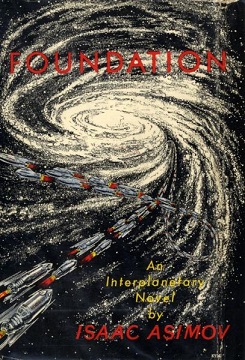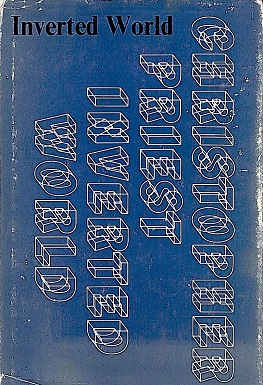
The Illustrated Man is a 1951 collection of 18 science fiction short stories by American writer Ray Bradbury. A recurring theme throughout the stories is the conflict of the cold mechanics of technology and the psychology of people. It was nominated for the International Fantasy Award in 1952.

The Foundation series is a science fiction book series written by American author Isaac Asimov. First published as a series of short stories and novellas in 1942–50, and subsequently in three books in 1951–53, for nearly thirty years the series was widely known as The Foundation Trilogy: Foundation (1951), Foundation and Empire (1952), and Second Foundation (1953). It won the one-time Hugo Award for "Best All-Time Series" in 1966. Asimov later added new volumes, with two sequels, Foundation's Edge (1982) and Foundation and Earth (1986), and two prequels, Prelude to Foundation (1988) and Forward the Foundation (1993).

Apocalyptic and post-apocalyptic fiction is a subgenre of science fiction in which the Earth's civilization is collapsing or has collapsed. The apocalypse event may be climatic, such as runaway climate change; astronomical, an impact event; destructive, nuclear holocaust or resource depletion; medical, a pandemic, whether natural or human-caused; end time, such as the Last Judgment, Second Coming or Ragnarök; or any other scenario in which the outcome is apocalyptic, such as a zombie apocalypse, AI takeover, technological singularity, dysgenics or alien invasion.

The Lensman series is a series of science fiction novels by American author E. E. "Doc" Smith. It was a runner-up for the 1966 Hugo Award for Best All-Time Series, losing to the Foundation series by Isaac Asimov.
"The Machine Stops" is a science fiction short story by E. M. Forster. After initial publication in The Oxford and Cambridge Review, the story was republished in Forster's The Eternal Moment and Other Stories in 1928. After being voted one of the best novellas up to 1965, it was included that same year in the popular anthology Modern Short Stories. In 1973 it was also included in The Science Fiction Hall of Fame, Volume Two.
The concept of self-replicating spacecraft, as envisioned by mathematician John von Neumann, has been described by futurists and has been discussed across a wide breadth of hard science fiction novels and stories. Self-replicating probes are sometimes referred to as von Neumann probes. Self-replicating spacecraft would in some ways either mimic or echo the features of living organisms or viruses.

Teal'c of Chulak is a fictional character in the 1997 military science fiction television series Stargate SG-1. Portrayed by Christopher Judge, Teal'c is a Jaffa warrior from the planet Chulak. As a Jaffa, Teal'c is a genetically modified human with an abdominal pouch that serves as an incubator for a larval Goa'uld. The larval symbiote grants enhanced strength, health, healing, and longevity; Teal'c is around 100 years old during the show's run and ages an additional 50 years in the final SG-1 episode. Teal'c's most notable feature is a golden tattoo found on his forehead, a sign that he once served the System Lord Apophis as First Prime, the most senior Jaffa rank.

The Songs of Distant Earth is a 1986 science fiction novel by British writer Arthur C. Clarke, based upon his 1958 short story of the same title. Of all of his novels, Clarke stated that this was his favourite. Prior to the publishing of the novel, Clarke also wrote a short step outline with the same title, published in Omni magazine and anthologised in The Sentinel in 1983.

Last and First Men: A Story of the Near and Far Future is a "future history" science fiction novel written in 1930 by the British author Olaf Stapledon. A work of unprecedented scale in the genre, it describes the history of humanity from the present onwards across two billion years and eighteen distinct human species, of which our own is the first. The book employs a narrative conceit that, under subtle inspiration, the novelist has unknowingly been dictated a channelled text from the last human species.
My Teacher Is an Alien is a four-book science fiction children's book series authored by Bruce Coville. The titles include:

Inconstant Moon is a science fiction short story collection by American author Larry Niven that was published in 1973. "Inconstant Moon" is also a 1971 short story that is included in the collection. The title refers to "O, swear not by the moon, th' inconstant moon", a quote from the balcony scene in William Shakespeare's Romeo and Juliet. The collection was assembled from the US collections The Shape of Space and All the Myriad Ways.

The mythology of the Stargate franchise is a complex and eclectic fictional backstory, which is presented as being historical, of the Stargate premise. A "rich mythology and world-building" are used to establish "a vast cosmology and an interesting alternate take on the history of Earth"; a defining feature is "its use of ancient mythology, with stories that take inspiration from multiple places around the globe". Narratives center around xeno-mythology as experienced by humans during episodic contact with alien races. Audiences across a variety of platforms - including TV series, novels, comics and movies - witness the people of Earth exploring a fictional universe using the Stargate. Species established early on in the franchise recur throughout, with one adversary often dominating a particular story arc, which can continue across several seasons.
"New Earth" is the first episode of the second series of the British science fiction television series Doctor Who. It was first broadcast on BBC One on 15 April 2006.

Raymond Fisher Jones was an American science fiction author. He is best known for his 1952 novel This Island Earth, which was adapted into the eponymous 1955 film.
"The Impossible Planet" is the eighth episode of the second series of the British science fiction television series Doctor Who, which was first broadcast on BBC One on 3 June 2006. It is the first part of a two-part story. The second part, "The Satan Pit", was broadcast on 10 June.

"Gridlock" is the third episode of the third series of the British science fiction television series Doctor Who, which was first broadcast on BBC One on 14 April 2007. It was written by Russell T Davies and directed by Richard Clark.

Murasaki is a 1992 "shared universe" hard science fiction novel in six parts to which Poul Anderson, Greg Bear, Gregory Benford, David Brin, Nancy Kress and Frederik Pohl each contributed one chapter; it was edited by Robert Silverberg. It is the first anthology of this type to be entirely conceived and written by winners of the Nebula Award.

For the imaginative concept where Earth's topography is inverted, see Inverted Earth.

Dying Earth is a subgenre of science fantasy or science fiction which takes place in the far future at either the end of life on Earth or the end of time, when the laws of the universe themselves fail. Dominant themes include world-weariness, innocence, idealism, entropy, heat death of the universe, exhaustion or depletion of many or all resources, and the hope of renewal. A related subgenre set in the distant future of entropic decay is called entropic romance.

Pathfinder (2010) is a science fiction novel by American author Orson Scott Card. The novel tells the story of Rigg and his unusual ability to perceive the "paths" of living things throughout time. It is the first book in the completed Pathfinder series, and is followed by Ruins and Visitors.















